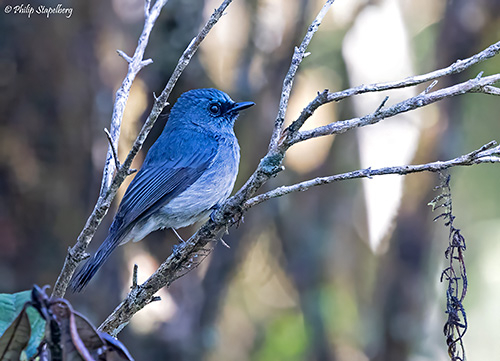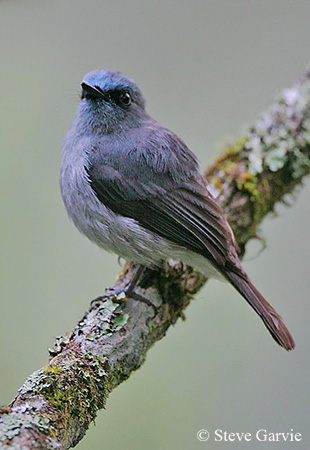
Fr: Gobemouche de Ceylan
Ang: Dull-blue Flycatcher
All: Ceylonschnäpper
Esp: Papamoscas de Ceilán
Ita: Pigliamosche bluastro
Nd: Ceylonvliegenvanger
Sd: ceylonflugsnappare
Photographers:
Steve Garvie
RAINBIRDER Photo galleries
Philip Stapelberg
GALLERY
Alan & Ann Tate
AA Bird Photography
Text by Nicole Bouglouan
Sources:
HANDBOOK OF THE BIRDS OF THE WORLD Vol 11 by Josep del Hoyo, Andrew Elliott and David Christie - Lynx Edicions - ISBN: 849655306X
A Field Guide to the Birds of Sri Lanka by John Harrison – Editor: OUP Oxford, 2011 – ISBN: 0199585660, 9780199585663 – 208 pages
Birds of the Indian Subcontinent: India, Pakistan, Sri Lanka, Nepal, Bhutan, Bangladesh and the Maldives - By Richard Grimmett, Carol Inskipp, Tim Inskipp – Editor : Bloomsbury Publishing, 2016 – ISBN: 1408162652, 9781408162651 – 528 pages
Researchgate - Breeding biology of the endemic Dull-blue Flycatcher Eumyias sordidus in Sri Lanka
Sri Lanka Dull-blue Flycatcher (Eumyias sordida)
CREAGUS@Monterey Bay (Don Roberson)
Fatbirder - The World’s Richest Information Resource about Birds for Birders
Wikipedia, the free encyclopaedia
Dull-blue Flycatcher
Eumyias sordidus
Passeriformes Order – Muscicapidae Family
INTRODUCTION:
The Dull-blue Flycatcher is resident and endemic to Sri Lanka where it is found in S and SW of the island, usually in the highlands.
It feeds primarily on various invertebrates, flying insects, caterpillars and larvae, but it also takes berries.
The species is monogamous and both adults share the nesting duties. The cup-shaped nest is built in natural cavity in rock, bank, branch or tree trunk. It usually breeds in tropical montane cloud forests.
The Dull-blue Flycatcher is affected by degradation of the habitat within the restricted range. Forests have been degraded and fragmented over large areas in 1956 and 1983, and the species may become threatened if this loss continues.
The Dull-blue Flycatcher is currently considered Near Threatened.

DESCRIPTION OF THE BIRD:
Biometrics:
Length: 14-15 cm
The Dull-blue Flycatcher has slaty blue plumage overall with paler underparts.
The upperparts, including wings and tail, are grey-blue. On the upperwing, the edges of tertials and inner secondaries are brighter blue.
On the underparts, throat and breast to upper flanks are pale blue, whereas belly, underwing, vent and undertail-coverts are whiter. The underwing-coverts show some buffy tinge.
On the head, the area extending from the forehead to sides of the crown is bright azure-blue. These feathers may be occasionally raised in displays. We can see a conspicuous black line extending from lores and chin to the eye. This black area is bordered below by cobalt-blue on cheeks to sides of the throat. The rest of the head is like the upperparts.
The bill is black. The eyes are dark brown. Legs and feet are black.
Male and female are similar, but the female has slightly duller plumage.
The juvenile is dark brown above, with heavy pale buff spotting on head, back and wing-coverts. The buffish throat and breast show darker markings. Belly and vent are mostly pale greyish with dark spots. Wings and tail have bluish edges, and both median and greater coverts have buffish tips.
RANGE:
The Dull-blue Flycatcher is found in S and SW of Sri Lanka to which it is endemic.
HABITAT:
The Dull-blue Flycatcher frequents the highlands of the island. Its preferred habitat is the cloud forest with a good canopy cover.
The species breeds in deciduous mountain forests usually above 600 metres, but mostly between 600 and 900 metres of elevation. However, it may sometimes reach up to 1,200/1,800 metres.
It is mainly seen in forests and well-wooded areas, but it is also observed along streams running through the forest, or along borders of jungle paths, and even in large gardens and edges of plantations, or ravines.
It may occasionally descend down to 450 metres during the non-breeding season.
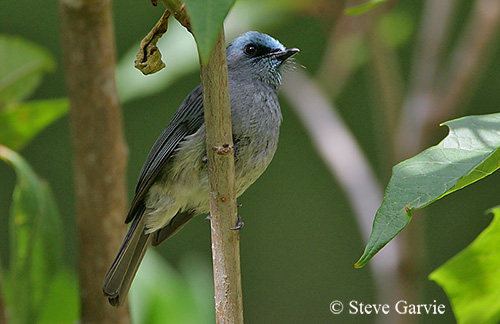
CALLS AND SONGS: SOUNDS BY XENO-CANTO
The Dull-blue Flycatcher is known for its loud, melodic song, a clear, rather mournful song composed of 6-8 notes and frequently uttered.
We can also hear a similar but lower sub song with ventriloquist character. This sound seems to be stronger and coming from a distance, but usually, the bird is relatively close.
The most frequent call is a series of 4-5 “chip” notes.
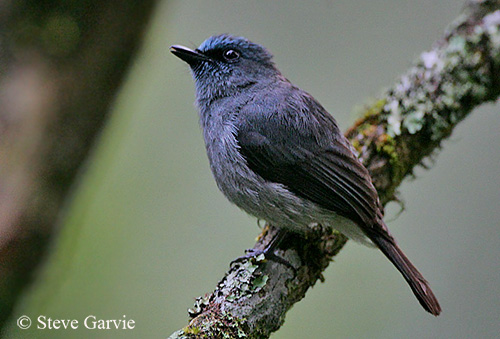
BEHAVIOUR IN THE WILD:
The Dull-blue Flycatcher primarily feeds on small invertebrates such as beetles (Coleopteran), caterpillars, larvae and flying insects. But berries of Rubus, Lantana and other shrub species are also part of its diet.
The flying insects are caught by sallying from low branches or other low, exposed perches.
This species also forages near the ground in branches and undergrowth, and on the ground among rocks, fallen branches and trees.
The Dull-blue Flycatcher is usually seen foraging alone or in pairs. They are not shy or secretive, and they sometimes spend long periods quiet and inactive.
At the beginning of the breeding season, the Dull-blue Flycatcher is observed defending the territory and chasing opposite sex-individuals.
The nest is a cup-shaped structure built inside a natural cavity. The male guards the female while she is building the nest, and it remains in close proximity to its mate. When an intruder approaches the nest-site, the male starts to sing while the female flies away discreetly through the low vegetation.
The species is monogamous, and both adults share the nesting duties.
The Dull-blue Flycatcher is resident in Sri Lanka.
The flight of this species is not clearly described, but usually, the flycatchers perform fluttering flight with shallow wingbeats. As a non-migratory species, it is mainly active when hunting by sallying from perches. It may also hover at bushes for picking berries.
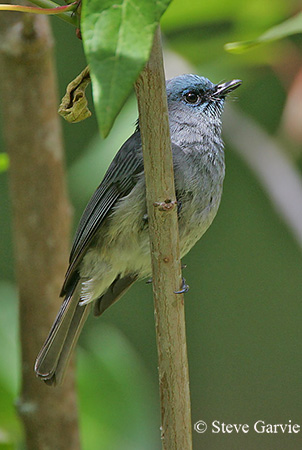
REPRODUCTION OF THIS SPECIES:
The breeding season takes place from mid-March to September, with peak in March-April. But a second clutch is often laid later in the year.
The nest is built by the female guarded by the male. The cup-shaped structure is built in natural cavities such as a hole in rock face, a crevice in mossy bank, a ledge or a hole in branch or tree trunk. The nest is made of moss, plant fibres and leaves. It is usually placed between 1 and 6 metres above the ground.
The female usually lays 2 pinkish-buff eggs with glossy surface. They are laid 24 hours apart.
The incubation lasts about 16 days and is shared by both adults. The nestling period lasts 15 days. The chicks are fed on invertebrates by both parents. A second clutch may be laid if the first is lost.
The main predator is the Eastern Jungle Crow (Corvus levaillantii).
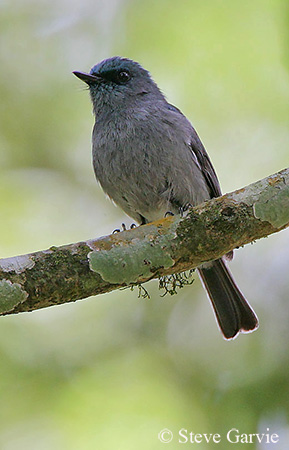
PROTECTION / THREATS / STATUS:
The Dull-blue Flycatcher is threatened by forest degradation and fragmentation caused in the past decades by excessive gathering of fuel wood, clearance for agriculture expansion, logging, urbanisation and fire.
If this loss continues, the species will be seriously threatened.
However, it occurs in several protected areas within the restricted range.
The size of the population is unknown, but the species is described as common, especially at higher elevations. The numbers are suspected to be declining due to habitat destruction.
But currently, the Dull-blue Flycatcher is considered Near Threatened.
